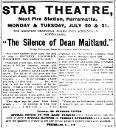AustLit
 1007742625178596278.jpg
1007742625178596278.jpg
Advertisement, The Cumberland Argus and Fruitgrowers Advocate, 8 July 1914, p.3 (via Trove Australia)
Adaptation of
The Silence of Dean Maitland
1886
single work
novel
Issue Details:
First known date:
1914...
1914
The Silence of Dean Maitland
The material on this page is available to AustLit subscribers. If you are a subscriber or are from a subscribing organisation, please log in to gain full access. To explore options for subscribing to this unique teaching, research, and publishing resource for Australian culture and storytelling, please contact us or find out more.
Film Details - Fraser Film Release and Photographic Company , 1914
Production Companies:
Fraser Film Release and Photographic Company.
Director of Photography:
Tasman Higgins.
Cast:
Including Gwil Adams (Lilian, Cyril's sister), Nellie Brooks (Alma Lee), Ada Clyde (Mrs Lee), Jack Goodall (unknown role), Rebe Grey (Marion Maitland), Charles Keegan (Cyril's father), Nellie Kemberman (Cyril's mother), Lottie Lyell (Marion, Henry's sister), James Martin (Ben Lee), Arthur Shirley (Doctor Henry Everard), Harry Thomas (Reverend Cyril Maitland), Little Tuppeny (Everard Maitland), and Charles Villiers (Judkins).
Release Dates:
13 June 1914 (Australia).
Location:
- Shot on location in the grounds of Gladesville Mental Asylum in Sydney.
Notes:
1. According to a retrospective on Australian film published in the Sydney Morning Herald in the 1930s, 'Mr Howell claimed that the first "close-up" was taken not by D. W. Griffith, as was claimed by many but by Raymond Longford in the silent film of "The Silence of Dean Maitland." Mr Harry Thomas played the part of the dean. During the confession sermon the camera was concentrated on his face while he mouthed the words. When the picture was projected, he stood behind the screen and spoke the lines' (Mon. 29 Jan. 1934, p.6).
2. The film was the subject of a court case in late 1914. According to a report in the Sydney Morning Herald, 'This was an action brought by Raymond Hollis Longford against Henry Ernest Odell Gee, in which plaintiff complained that he had a contract with one C. W. Fraser for the supply and production of moving picture plays, and defendant, while the contract was still in force, unlawfully, maliciously, and wrongfully, and against the will of the plaintiff, induced Fraser to break it, whereby plaintiff lost the profits he would have made from the contract, and from the supply and production of picture plays with Fraser and other persons, and was injured in his calling and profession. Plaintiff's case, as stated by his counsel, was that he was an actor by profession, and had been engaged for some time dramatising novels for moving picture plays. He entered into a contract with J. W. Fraser, by which the latter undertook to screen pictures from plays written and adapted for that purpose by plaintiff, and to pay him £1000 per annum. That contract was made in May of this year. Among other plays, plaintiff wrote a dramatic adaptation of "The Silence of Dean Maitland," which was
to be shown by Fraser in Sydney and suburbs. This was first exhibited at the Criterion Theatre on June 9, but subsequently Fraser came to him, and told him that he could not proceed further with the contract in consequence of what defendant had said to
him. Plaintiff thereupon went to defendant, who was connected with the Australasian Films, Ltd., and repeated the conversation he had had with Fraser. Geo admitted that he had interfered to prevent the further production of the play, and said it was no use plaintiff running his head against a stone wall. Plaintiff then said, "Fraser tells me that if he carries out the contract you will boycott him." Gee replied, "I have to stop it, and if Fraser goes on with you I shall boycott him throughout Australia." Plaintiff said that his business was absolutely brought to an end under his contract, and that he had lost not only £1000 a year, but claimed that he was also entitled to the prospective profits he would have made if he had been allowed to proceed with his contract. Damages were laid at £2000' (Thurs. 24 Sep. 1914, p.5)


